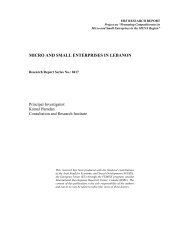View - ResearchGate
View - ResearchGate
View - ResearchGate
Create successful ePaper yourself
Turn your PDF publications into a flip-book with our unique Google optimized e-Paper software.
n<br />
z t = γ 0 + ∑ i =<br />
γ<br />
1 i z t-i + γ h h t + η t (4)<br />
where z t is the variable for TFP, investment, exchange rate, or employment.<br />
Specifically, growth is regressed on its own lag and the conditional variance of growth, and<br />
each TFP, investment, exchange rate, and employment variable is regressed on its own lag<br />
and the conditional variance of growth. Then, we assess how the conditional variance of<br />
growth rates affects growth itself as well as each TFP, investment, exchange rate, and<br />
employment variable. Equations 1, 3, and 4 could be estimated individually. Pagan (1984)<br />
argues that using generated variables from a stochastic process in an estimation process could<br />
lead to biased estimates. Pagan and Ullah (1988) suggest using Full Information Maximum<br />
Likelihood estimates to avoid biased estimates. Therefore, equations 1, 3, and 4 are estimated<br />
jointly using the Full Information Maximum Likelihood estimation method with the Broyden,<br />
Fletcher, Goldfarb, and Shanno algorithm.<br />
3. Data<br />
The data set used in this paper is quarterly data for Turkey from 1987Q1 to 2007Q3 1 . The<br />
GDP growth, investment and employment data are from the Turkish Statistical Institute<br />
(TURKSTAT). The investment variable used in the model is the ratio of investment to GDP,<br />
while GDP growth is the logarithmic first difference of real GDP. Capital stock is calculated<br />
from investment data using the methodology of the OECD and is taken from Cihan, Saygili,<br />
and Yurtoglu (2005). TFP, the usual Solow residual from a Cobb-Douglas type production<br />
function with constant returns to scale, was obtained from the State Planning Organization of<br />
Turkey. The real exchange rate is calculated in terms of US dollars and deflated with the<br />
USA All Urban Consumer Price Index, where an increase in the index represents (real)<br />
appreciation. All the series enter into the analysis in their logarithmic first difference form,<br />
except investment; investment is entered in the analysis as its ratio to GDP. All data is<br />
seasonally adjusted.<br />
4. Estimates<br />
Table 1 reports the growth-growth volatility relationship for Turkey 2 . The growth volatility is<br />
captured by the EGARCH (1, 2) specification of conditional variance under generalized error<br />
distribution. 3&4 The estimates of the parameters for the first growth equation include constant<br />
1<br />
The Turkish Statistical Institute made a methodological change in calculating the national account data starting at the<br />
beginning of 2008. It is important to note that it is not easy to combine these two data sets for extending the period as they<br />
are based on different methodologies. As GDP based on the new methodology is around 30 percent higher in nominal terms<br />
than the previous one, we use the previous version of the national accounts data, which covers the period 1987Q1-2007Q3.<br />
2<br />
An earlier version of estimates for Turkey is reported as part of the World Bank’s (2006) Country Economic Memorandum<br />
for Turkey.<br />
3<br />
t<br />
The EGARCH model can be estimated using maximum likelihood by specifying a density for<br />
ht<br />
Nelson proposed the following functional form using the generalized error distribution, normalized to have zero mean and<br />
unit variance for the distribution function of the error term:<br />
ε<br />
where Г(.) is the gamma distribution, λ is a constant given by<br />
[ −2 / D] 1/ 2<br />
⎡2<br />
Γ(1/<br />
D)<br />
⎤<br />
λ and D is a positive parameter determining the thickness of the tails. For D=2, the equation<br />
= ⎢<br />
⎣<br />
Γ(3/<br />
D)<br />
⎥<br />
⎦<br />
becomes the standard Normal density. If D2, it has thinner tails.<br />
4<br />
The lag orders of the EGARCH specifications are determined such that standardized errors are no longer autocorrelated.<br />
5

















